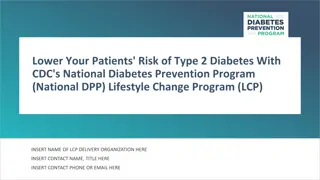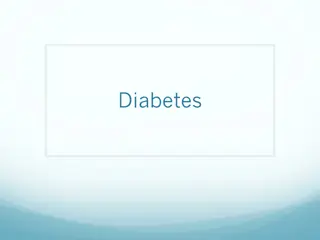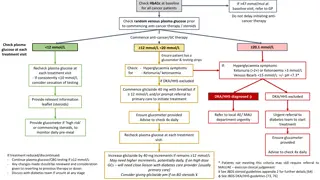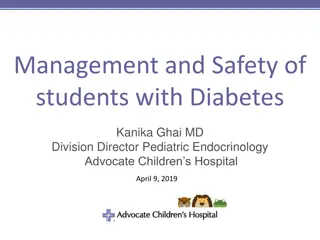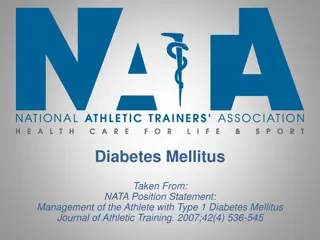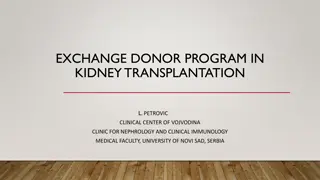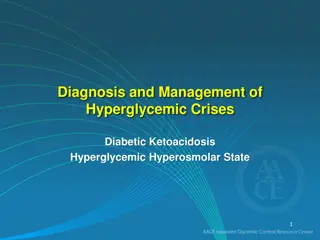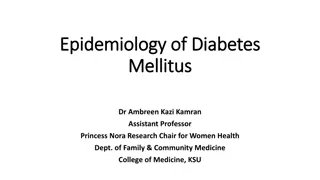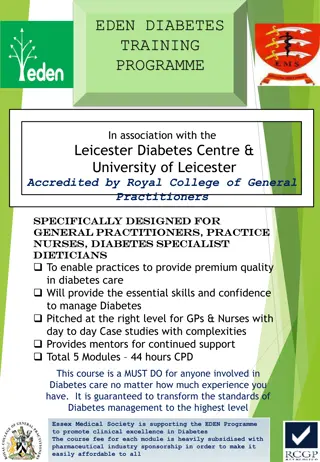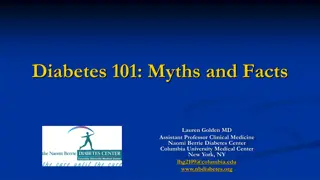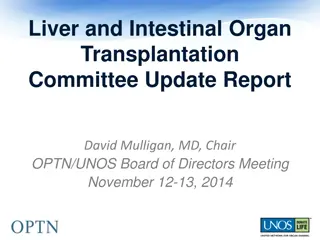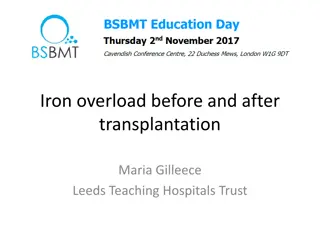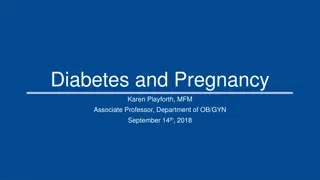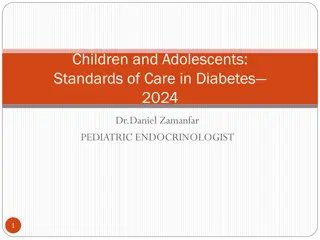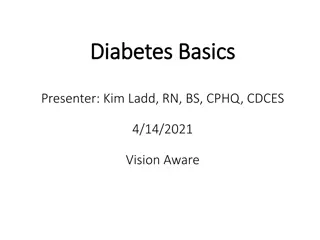
Post-Transplantation Diabetes Management Insights
Post-Transplantation Diabetes Mellitus (PTDM) is a significant complication following organ transplantation, impacting patient outcomes and healthcare costs. This article explores the incidence, impact, and management strategies for hyperglycemia in PTDM patients, highlighting the importance of early detection and intervention to improve prognosis and reduce complications.
Download Presentation

Please find below an Image/Link to download the presentation.
The content on the website is provided AS IS for your information and personal use only. It may not be sold, licensed, or shared on other websites without obtaining consent from the author. If you encounter any issues during the download, it is possible that the publisher has removed the file from their server.
You are allowed to download the files provided on this website for personal or commercial use, subject to the condition that they are used lawfully. All files are the property of their respective owners.
The content on the website is provided AS IS for your information and personal use only. It may not be sold, licensed, or shared on other websites without obtaining consent from the author.
E N D
Presentation Transcript
HYPERGLYCEMIA MANAGEMENT IN PATIENTS WITH POST-TRANSPLANTATION DIABETES 2015 AACE. Emerging treatments for post- transplantation diabetes mellitus Jenssen, T. & Hartmann, A. Nat. Rev. Nephrol. advance online publication 28 April 2015; doi:10.1038/nrneph.2015.59 .
Post-Transplantation Diabetes (PTDM) is a common occurrence after solid organ transplantation and is associated with increased morbidity, mortality and healthcare costs. There is limited number of studies addressing strategies for hyperglycemia management in this population, with few articles emerging recently.
Introduction: Post-Transplantation Diabetes Mellitus (PTDM), formerly known as New Onset Diabetes After Transplantation (NODAT), is one of the most problematic comorbidities of solid organ transplantation. PTDM is associated with increased mortality, overall graft failure, rate of acute rejection, infections, major-cardiovascular events . and earlier onset of diabetes-related microvascular complications .
INCIDENCE AND IMPACT OF NODAT IN RENAL TRANSPLANT PATIENTS The reported incidence of NODAT greatly depends on the length of follow-up, diagnostic criteria, and immunosuppression regimen. The true incremental incidence of diabetes occurs mainly during the first 6 months posttransplantation, when patients are treated with high doses of immunosuppression. After 6 months, the annual incidence of diabetes is similar to that observed in patients on the waiting list ( 6% per year) . Thus, late-onset cases of NODAT may be difficult to distinguish from genuine cases of type 2 diabetes. The most accurate incidence of NODAT under calcineurin inhibitor (CNI) therapy is provided by the prospective study of Vincenti et al. reporting an incidence of NODAT reaching 20.5% within the first 6 months postrenal transplantation.
Post-transplantation diabetes mellitus (PTDM), also known as new-onset diabetes mellitus (NODM), occurs in 10 15% of renal transplant recipients and is associated with cardiovascular disease and reduced lifespan.
Even though this disorder has been recognized for several years, it was not until the publication of a guideline in 2003 that the term NODAT and its definition were widely accepted . Transplant centers may be unable to effectively recognize dysglycemia during the pre-transplant evaluation; the term New-Onset Diabetes After Transplantation may therefore be misleading. Recently, an international consensus meeting acknowledged this concern and suggested using the term PTDM.
A historical overview of several terms used for transplant- related dysglycemia is illustrated in Figure 1.
Diagnosis : Current PTDM guidelines recommend the use of: fasting blood glucose, 2-hours oral glucose tolerance test and/or A1c for diagnosis, as endorsed by the American Diabetes Association . .
the posttransplant period is frequently associated with anemia (due to surgical blood loss, iron deficiency, immunosuppressive drugs, graft dysfunction, and abrupt discontinuation of erythropoietin administration), resulting in spurious A1C results . Likewise, glucose levels rather than A1C must be used as screening in case of rapid onset of diabetes, a situation encountered after high-dose glucocorticoid administration.
Thus, maintaining A1c < 7% is generally recommended with the understanding that no definitive data exists for this population. The concept of individualized glycemic targets based on risk assessment is widely used, thus A1c goals of up to 8% in patients with high risk of hypoglycemia, limited life expectancy, advanced micro/macrovascular complications or extensive co-morbidities may be acceptable .
Methods: We performed a Pubmed search of studies published in English addressing hyperglycemia management of PTDM/NODAT. Relevant cited articles were also retrieved. Our review was designed to answer the following questions: 1) what is the efficacy of various available therapies for hyperglycemia management in PTDM and 2) what is known about the safety of available glucose-lowering agents in this population?
and Our inclusion criteria were: adult subjects (>18 years of age), diagnosis of NODAT and use of glucose-lowering therapy. We excluded children (< 18 years of age), patients with known pre-transplant diabetes and studies not addressing glucose-lowering agents. Out of 400 abstracts matching the search criteria, 25 studies that met our inclusion criteria are reviewed here.
Results: Most of the 25 publications eligible for review were retrospective studies. Insulin therapy during the early post-transplantation period has shown promise in preventing PTDM development. Thiazolidine diones have shown glycemia control, mostly, in retrospective studies, at the expense of weight gain and fluid retention. Evidence with metformin, sulfonylureas and meglitinides is very limited. Incretins have shown promising results in small prospective studies using sitagliptin, linaglitpin and vildagliptin and in a case series using liraglutide.
Renal transplant recipients with NODAT exhibit similar complications as those seen in the general population with type 2 diabetes, but at an accelerated rate . As a consequence, NODAT is associated with worse outcomes after renal transplantation, such as a higher risk of major cardiovascular events, graft failure, death-censored graft failure, and death . In addition, this metabolic complication substantially increases medical costs .
RISK FACTORS Risk factors shared with type 2 diabetes in the general population As observed in type 2 diabetes in the general population, older age is a strong independent risk factor of NODAT. There is a 90% increase of relative risk (RR) in renal transplant patients aged 45 59 and a 160% increase in patients 60 (versus 18 44 years as a reference). The RR of NODAT is increased by 32 68% in black patients and by 35% in Hispanic patients in comparison with white patients. Overweight or obese patients have a higher risk of developing NODAT, with an RR of 1.4 for patients with a BMI between 25 and 30 kg/m2 and an RR of 1.7 1.8 for patients with a BMI >30 kg/m2. The RR of NODAT associated with a positive hepatitis C virus (HCV) serology ranges from 1.3 to 1.4 .
With regard to cytomegalovirus (CMV), a group showed that both ganciclovir-treated and asymptomatic CMV infection episodes are independent risk factors of NODAT. Likewise, there is no clear relationship between positive CMV serological status and the risk of type 2 diabetes in the general population.
The role of a family history of diabetes in predicting NODAT is unclear,as it has not been evaluated in large registry reports. However, a family history of type 2 diabetes emerged as a significant risk factor associated with NODAT in multivariate analysis of several studies. Retrospective studies reported a higher incidence of NODAT in patients with a metabolic syndrome at baseline. Patients with an increasing number of criteria are more likely to develop NODAT (74% of patients with five pretransplant criteria developed NODAT) .
The risk of NODAT increases stepwise with pretransplant FPG level (FPG 101 110, odds ratio [OR] 1.5; FPG 110 125, OR 7.6) . The 2-h plasma glucose level after an oral glucose tolerance test (OGTT) correlates with the risk of NODAT (OR 1.26 per 1 mmol/L or 18 mg/dL). Pretransplantation hypertriglyceridemia was also shown to correlate with NODAT .
Since the first genome-wide association study (GWAS) in 2007, >40 confirmed loci have been associated with type 2 diabetes in the general population. . One of the largest ORs was 1.55 and was observed in nonobese patients with genetic polymorphism rs7903146 (T allele), a common variant in the TCF7L2 (transcription factor 7- like 2) gene . This allele has been associated with impaired insulin secretion, incretin effect, and enhanced rate of hepatic glucose production in humans .
Thus, although the association of TCF7L2 with NODAT highlights a major common mechanistic pathway with type 2 diabetes, we do not currently recommend genotyping TCF7L2 for individual risk prediction of NODAT today.
Hypomagnesemia induced by CNIs (more common with tacrolimus) is due to renal magnesium wasting occurring through transcriptional inhibition of the renal magnesium transporter in the distal collecting tubule. Recently, posttransplantation hypomagnesemia was found to be an independent predictor of NODAT in both renal and liver transplant. This finding is in line with data from the general population where hypomagnesemia cross-sectionally associates with insulin resistance in obese children and with a metabolic syndrome in both diabetic and nondiabetic adults.
hypomagnesemia might merely represent a surrogate marker or be a consequence of insulin resistance, inflammation, or endothelial dysfunction, which are all risk factors for diabetes in the general population. Although magnesium supplementation has previously demonstrated a beneficial impact on insulin resistance in the general population, randomized, controlled trials assessing the impact of early posttransplantation magnesium supplementation on glucose metabolism, which are ongoing, will hopefully shed light on this still controversial issue .
Specific factors related to transplantation Although the type of donor (deceased versus living) is not an independent risk factor for NODAT, immunosuppression is a major factor contributing to the risk of NODAT. The diabetogenic effect of glucocorticoids, mainly due to insulin resistance, is mediated by both impaired insulin-dependent glucose uptake in the peripheral tissues and enhanced gluconeogenesis in the liver. High-dose glucocorticoid regimens used during the 1970s were associated with a very high incidence of so-called steroid diabetes, which declined when cyclosporine was introduced as an immunosuppressant in the 1980s.
However, pulse glucocorticoid therapy still given in the context of acute rejection treatment remains an independent risk factor of NODAT . . However, both steroid-sparing strategies were associated with higher acute rejection rates and higher risk of graft loss excluding death . Therefore, in patients at high risk of NODAT, a glucocorticoid minimization strategy should be balanced with the immunological risk profile to avoid acute rejection and graft loss.
CS may lead to increased hepatic gluconeogenesis, development of insulin resistance and defective insulin secretion . Improvement of insulin sensitivity in post-transplant subjects was noticed upon CS dose reduction and withdrawal , suggesting a dose-related increase in insulin resistance.
CNIs are diabetogenic by inducing a defect in insulin secretion by interfering with the nuclear factor of activated T-cell signaling in pancreatic . Tacrolimus induces a reversible suppression of insulin secretion at the level of insulin mRNA transcription, mediated by the binding of the drug to FK506 binding protein-12 and a subsequent inhibition of calcineurin in the -cells. The high level of FK506 binding protein-12 present in pancreatic -cells might explain why tacrolimus more profoundly inhibits insulin secretion than cyclosporine.
Registry analyses, meta-analyses, and the prospective study of Vincenti et al. showed that the risk of NODAT was significantly higher in patients on tacrolimus versus cyclosporine . Recent data suggest that tacrolimus may also induce beta-cell apoptosis .
The risk of NODAT related to tacrolimus is dose dependent and high trough levels enhance this risk, in particular during the early posttransplant period . Indeed, studies comparing belatacept (a molecule that inhibits T-cell activation) with a cyclosporine-based regimen showed that NODAT developed in 6.7% of patients on cyclosporine versus 3.5% of belatacept patients at 12 months (P = 0.018). We showed that 42% of switched patients experienced a resolution of NODAT, whereas this never occurred in patients remaining on tacrolimus, after a follow-up of 1 year .
There is now strong evidence that m-TOR (mammalian target of rapamycin) inhibitors cause alterations in glucose metabolism. This diabetogenic effect is probably due to a combination of an insulin secretion defect (toxicity to -cells) and insulin resistance. Sirolimus has been associated with an increased risk of NODAT in large North American and European cohorts. The risk is particularly high when sirolimus is associated with a CNI. Experimental and clinical data on everolimus, the other m- TOR on the market, are more scant.
Acute vs chronic hyperglycemia Many patients develop inpatient post-transplantation hyperglycemia, afflicting > 80% of patients without pre- transplant diabetes . It is currently recommended to differentiate this common phenomenon from that of PTDM a more persistent and chronic insulin-deficient and resistant state .
Current guidelines recommends: waiting for up to 45 days post-transplantation before assigning the diagnosis of PTDM, but recommended treating patients with early post-transplant hyperglycemia with insulin therapy, especially in the hospital.
Chronic Hyperglycemia: Transient/Reversible vs Persistent vs Recurrent PTDM Many patients will have improvement of their dysglycemia once the dose of immunosuppressive therapies is decreased. Consequently, PTDM has been classified as early-onset or late-onset, based on the time of diagnosis (before or after 3 months), or as persistent, recurrent and reversible (transient), based on the long- term clinical evolution.
Acute hyperglycemia management during the inpatient/peri-transplant period Extensive literature supports inpatient glucose control to improve hospital-related outcomes and mortality in the general patient population . However, the literature is remarkably limited in the transplant population . Only one prospective randomized trial has been published on the acute management of hyperglycemia during the peri-transplant period.
Hermayer et al. showed that intensive glycemic control (blood glucose target of 70-110 mg/dl) compared to standard-of-care (blood glucose target < 180 mg/dl) in the immediate 3-day- posttransplant period was associated with: increased incidence of graft rejections (p=0.012), delayed graft function (18% vs 24%, p=0.46) and more hypoglycemic events (p=0.08) in kidney transplant recipients. This study, however, only included patients with pretransplant diabetes .
A retrospective study of 92 heart transplant recipients, 28% of whom had preexisting DM, who were managed with insulin in the early post-transplant period was recently published. The authors reported their experience using a standardized insulin infusion protocol while in the intensive care unit (ICU) and a basal-bolus insulin regimen, with a target fasting blood glucose of 80-110 mg/dl. There were no significant differences in blood glucose, 30-day all-cause mortality, ICU length-of-stay, rejection episodes, 30- day readmission rate between patients with preexisting DM and those who were newly experiencing hyperglycemia.However, the rates of moderate hypoglycemia (40-69 mg/dl) were 19% when using insulin infusion protocols and 27% while on the subcutaneous basal-bolus regimen .
Hypoglycaemia Hypoglycaemic episodes are detrimental in patients with advanced arteriosclerosis, and in some cases, asymptomatic coronary artery disease,and hypoglycaemic episodes are common in patients with uraemia. In the absence of renal failure, the kidneys contribute 50% of total gluconeogenesis, which equates to 25% of total endogenous glucose production Hypoglycaemia might also cause lengthening of the QT interval observed by echocardiography and induce pro-arrhythmic repolarization changes.
Based on the available but limited information, glycemic targets of 140-180 mg/dl (with a lower target of 110-140 mg/dl for selected patients at a lower risk of hypoglycemia) seem reasonable for critically ill patients, as generally recommended. For non-critically ill patients, a target pre-meal blood glucose <140 mg/dl and random blood glucose < 180 mg/dl is recommende.
Wide and abrupt changes in glycemia can occur during these periods, requiring daily evaluation of the insulin regimen. Several factors such as nutrition, pain, infection and steroid dose may drastically change during this period, influencing the insulin doses.
There are no studies specifically addressing whether early insulin therapy is better than non-insulin agents in this population. However, a recent pilot study by Hecking et al suggested that early basal insulin reduces the risk of PTDM. The authors suggested that early exogenous insulin supplementation might prevent beta-cell exhaustion while it s exposed to the toxic effects of immunosuppressants and inflammatory stress .
Insulin is the preferred agent during the immediate and early post-transplant period, particularly during acute illness or when high doses of corticosteroids or CNIs are used. Oral agents with low risk for hypoglycemia such as DDP-4 inhibitors and meglitinides - particularly in patients with renal dysfunction - might be more appropriate after the immediate post-transplant/stress response period or hospitalization.
Chronic Hyperglycemia There is insufficient evidence to recommend a first choice agent for chronic hyperglycemia in these patients. Special consideration should be given to the side effect. profile as well as the effectiveness of each agent in achieving glycemic targets, drug interactions and medication cost. There is extensive evidence of the benefits of long-term glycemia control in preventing microvascular and macrovascular complications in the general diabetes population .
Glucose-lowering treatment Glucose-lowering therapy in PTDM involves three approaches: lifestyle intervention, changes in the immunosuppressive regimen initiation of glucose-lowering treatment
General measures: Transplant recipients have a tendency to gain weight after transplantation. Obesity is associated with increased risk for development of PTDM and worse transplant-related outcomes . A healthy diet and regular exercise is encouraged. . A randomized control trial in kidney transplant recipients studied the effect of an immunomodulatory diet, rich in omega-3 and omega-9 fatty acids. Patients who received L-arginine supplements and canola oil had decreased rejection rates, CNIs toxicity and lower incidence of PTDM .


